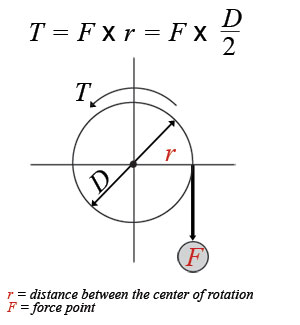The above equation can be rearranged to compute the torque required to achieve given angular velocity and Power. The torque injects power and it purely depends on instantaneous velocity. Relationship Between Torque and Power. For any rotatory motion, to derive the relation between torque and Power, compare the linear equivalent. In moving iron instruments, the gravity or spring provides the controlling torque to the instrument. Whereas in moving coil instrument the spring provides the controlling torque to the moving coil instrument. The deflection of the moving iron instrument is proportional to the current. In order to find out the expression for deflecting torque in case of rotary type electrostatic instruments, just replace the in the equation (1) F by T d and dx by dA. Now rewriting the modified equation we have deflecting torque is equals to Now at steady state we have controlling torque is given by the expression T c = K × A.

- Torque Equation of PMMC Instrument As you know, there are three types of torque acting on an instrument. In this section, you will derive and learn the equation of deflection torque, control torque and damping torque in a PMMC instrument.
- Three Phase Induction MotorsRotating magnetic field, construction & principle of operation, slip, rotor frequency, development of equivalent circuit, torque equation, maximum torque, torque speed characteristics, speed control. Starting methods, motor ratings.Stepper MotorPrinciple of working, characteristics & applications.
Construction & Working : simply in brief , there is a coil which is free to move and is surrounded by powerfull magnets. Now we dicuss in detail ..
There is a two powerfull U-shaped magnets in the instrument. The ends of magnets have soft iron piece called pole pieces ..these iron pieces are attached to the magnets to decrease the air gap hence reluctance and to provide low reluctance path for the magnetic field produced by the permannent magnets.
Between these magnets , a coil wound on aluminium and copper core is placed which is free to rotate ..the coil is mounted on spindle to which pointer is also attached.
When current to be measured flows through the coil than two fields acts on the coil i.e. field produced by the coil current and field produced by the permannent magnets. Two field will act on the coil and causes the coil to rotate .with the coil , spindle also moves than pointer also moves through the scale and gives the necessary reading on the scale.
Advantages and disadvantages
- Low power consumption
- Linear scale
- No hysteris loss
- Powerfull eddy current damping
- No effect of outside or external fields
- Instrument Range can be extended with shunts and multipliers
- High accuracy due to high torque weight ratio .
Disadvantages:
- Costly
- Errors due to ageing of control mechanism and magnets.
Deflecting Torque Equation
T= Force x distance
T= NBILxb Newton Meter
N= no of turns on the coil
B= flux density
L= length of coil
B= breadth of coil
I= currents flowing through coil
The permanent magnet moving coil instruments are most accurate type for direct current measurements. The action of these instruments is based on the motoring principle. When a current carrying coil is placed in the magnetic field produced by permanent magnet, the coil experiences a force and moves. As the coil is moving and the magnet is permanent, the instrument is called permanent magnet moving coil instrument. This basic principle is called D’Arsonval principle. The amount of force experienced by the coil is proportional to the current passing through the coil.
The PMMC instrument is shown in the below images.
The moving coil is either rectangular or circular in shape. It has number of turns of fine wire. The coil is suspended so that it is free to turn about its vertical axis. The coil is placed in uniform, horizontal and radial magnetic field of a permanent magnet in the shape of a horse-shoe. The iron core is spherical if coil is circular and is cylindrical if the coil is rectangular. Due to iron core, the deflecting torque increase, increasing the sensitivity of the instrument.
The controlling torque is provided by two phosphor bronze hair springs.
The damping torque is provided by eddy current damping. It is obtained by movement of aluminum former, moving in the magnetic field of the permanent magnet.
The pointer is carried by the spindle and it moves over a graduated scale. The pointer has light weight so that it deflects rapidly. The mirror is placed below the pointer to get the accurate reading by removing the parallax. The weight of the instrument is normally counter balanced by the weights situated diametrically opposite and rapidly connected to it. The scale markings of the basic d.c PMMC instruments are usually linearly spaced as the deflecting torque and hence the pointer deflections are directly proportional to the current passing through the coil.

The top view of PMMC instrument is shown in the below image.
Advantages of PMMC
The various advantages of PMMC instruments are,
It has uniform scale.
With a powerful magnet, its torque to weight ratio is very high. So operating current of PMMC is small.
The sensitivity is high.
The eddy currents induced in the metallic former over which coil is wound, provide effective damping.
Torque Equation Of Pmmc

It consumes low power, of the order of 25 W to 200 mW.
It has high accuracy.
Instrument is free from hysteresis error.
 Extension of instrument range is possible.
Extension of instrument range is possible.Not affected by external magnetic fields called stray magnetic fields.
Disadvantages of PMMC
The various disadvantages of PMMC instruments are ,
Torque Equation Of Pmsm
PMMC is Suitable for direct current measurement only.
Ageing of permanent magnet and the control springs introduces the errors.
The cost is high due to delicate construction and accurate machining.
The friction is due to jewel-pivot suspension.
